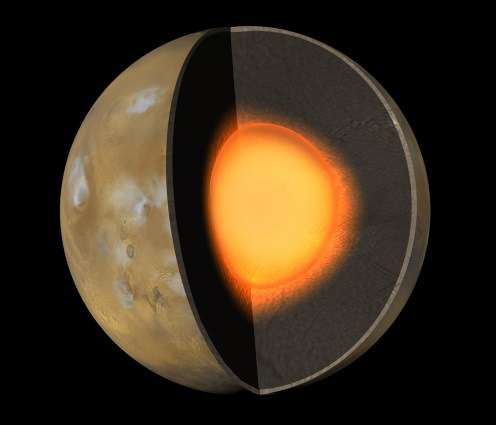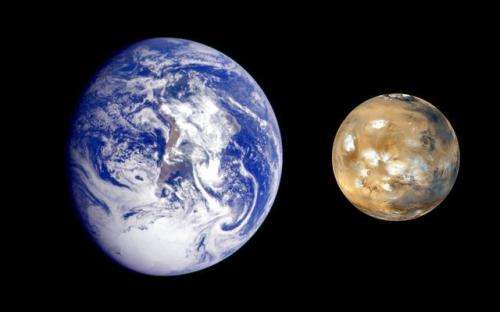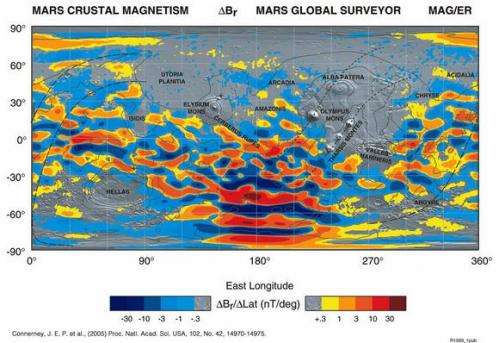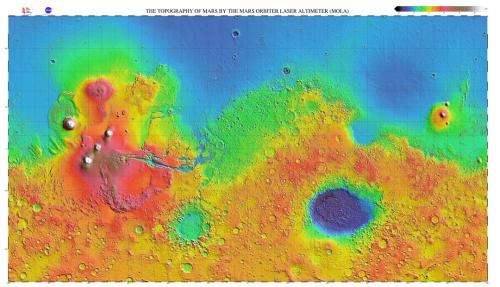What is Mars made of?

For thousands of years, human beings have stared up at the sky and wondered about the Red Planet. Easily seen from Earth with the naked eye, ancient astronomers have charted its course across the heavens with regularity. By the 19th century, with the development of powerful enough telescopes, scientists began to observe the planet's surface and speculate about the possibility of life existing there.
However, it was not until the Space Age that research began to truly shine light on the planet's deeper mysteries. Thanks to numerous space probes, orbiters and robot rovers, scientists have learned much about the planet's surface, its history, and the many similarities it has to Earth. Nowhere is this more apparent than in the composition of the planet itself.
Like Earth, the interior of Mars has undergone a process known as differentiation. This is where a planet, due to its physical or chemical compositions, forms into layers, with denser materials concentrated at the center and less dense materials closer to the surface. In Mars' case, this translates to a core that is between 1700 and 1850 km (1050 – 1150 mi) in radius and composed primarily of iron, nickel and sulfur.
This core is surrounded by a silicate mantle that clearly experienced tectonic and volcanic activity in the past, but which now appears to be dormant. Besides silicon and oxygen, the most abundant elements in the Martian crust are iron, magnesium, aluminum, calcium, and potassium. Oxidation of the iron dust is what gives the surface its reddish hue.
Beyond this, the similarities between Earth and Mars' internal composition ends. Here on Earth, the core is entirely fluid, made up of molten metal and is in constant motion. The rotation of Earth's inner core spins in a direction different from the outer core and the interaction of the two is what gives Earth it's magnetic field. This in turn protects the surface of our planet from harmful solar radiation.
The Martian core, by contrast, is largely solid and does not move. As a result, the planet lacks a magnetic field and is constantly bombarded by radiation. It is speculated that this is one of the reasons why the surface has become lifeless in recent eons, despite the evidence of liquid, flowing water at one time.

Despite there being no magnetic field at present, there is evidence that Mars had a magnetic field at one time. According to data obtained by the Mars Global Surveyor, parts of the planet's crust have been magnetized in the past. It also found evidence that would suggest that this magnetic field underwent polar reversals.
This observed paleomagnetism of minerals found on the Martian surface has properties that are similar to magnetic fields detected on some of Earth's ocean floors. These findings led to a re-examination of a theory that was originally proposed in 1999 which postulated that Mars experienced plate tectonic activity four billion years ago. This activity has since ceased to function, causing the planet's magnetic field to fade away.
Much like the core, the mantle is also dormant, with no tectonic plate action to reshape the surface or assist in removing carbon from the atmosphere. The average thickness of the planet's crust is about 50 km (31 mi), with a maximum thickness of 125 km (78 mi). By contrast, Earth's crust averages 40 km (25 mi) and is only one third as thick as Mars's, relative to the sizes of the two planets.
The crust is mainly basalt from the volcanic activity that occurred billions of years ago. Given the lightness of the dust and the high speed of the Martian winds, features on the surface can be obliterated in a relatively short time frame.
Much of Mars' composition is attributed to its position relative to the Sun. Elements with comparatively low boiling points, such as chlorine, phosphorus, and sulphur, are much more common on Mars than Earth. Scientists believe that these elements were probably removed from areas closer to the Sun by the young star's energetic solar wind.

After its formation, Mars, like all the planets in the Solar System, was subjected to the so-called "Late Heavy Bombardment." About 60% of the surface of Mars shows a record of impacts from that era, whereas much of the remaining surface is probably underlain by immense impact basins caused by those events.
The largest impact event on Mars is believed to have occurred in the northern hemisphere. This area, known as the North Polar Basin, measures some 10,600 km by 8,500 km, or roughly four times larger than the Moon's South Pole – Aitken basin, the largest impact crater yet discovered.

Though not yet confirmed to be an impact event, the current theory is that this basin was created when a Pluto-sized body collided with Mars about four billion years ago. This is thought to have been responsible for the Martian hemispheric dichotomy and created the smooth Borealis basin that now covers 40% of the planet.
Scientists are currently unclear on whether or not a huge impact may be responsible for the core and tectonic activity having become dormant. The InSight Lander, which is planned for 2016, is expected to shed some light on this and other mysteries – using a seismometer to better constrain the models of the interior.
Source: Universe Today





















